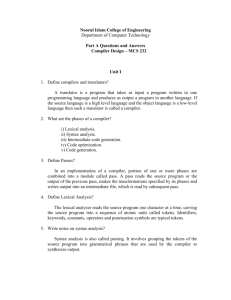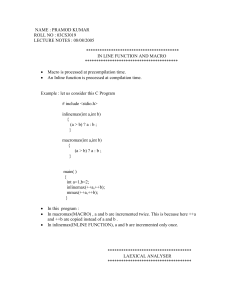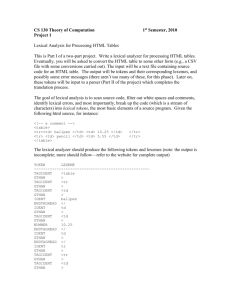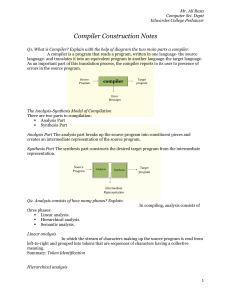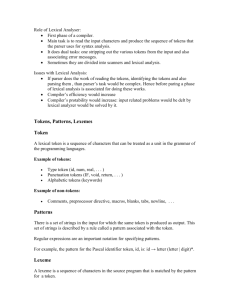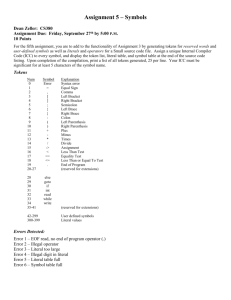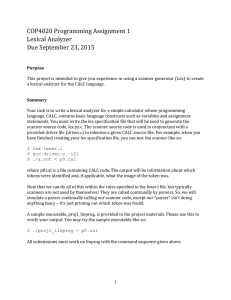ch1-2
advertisement
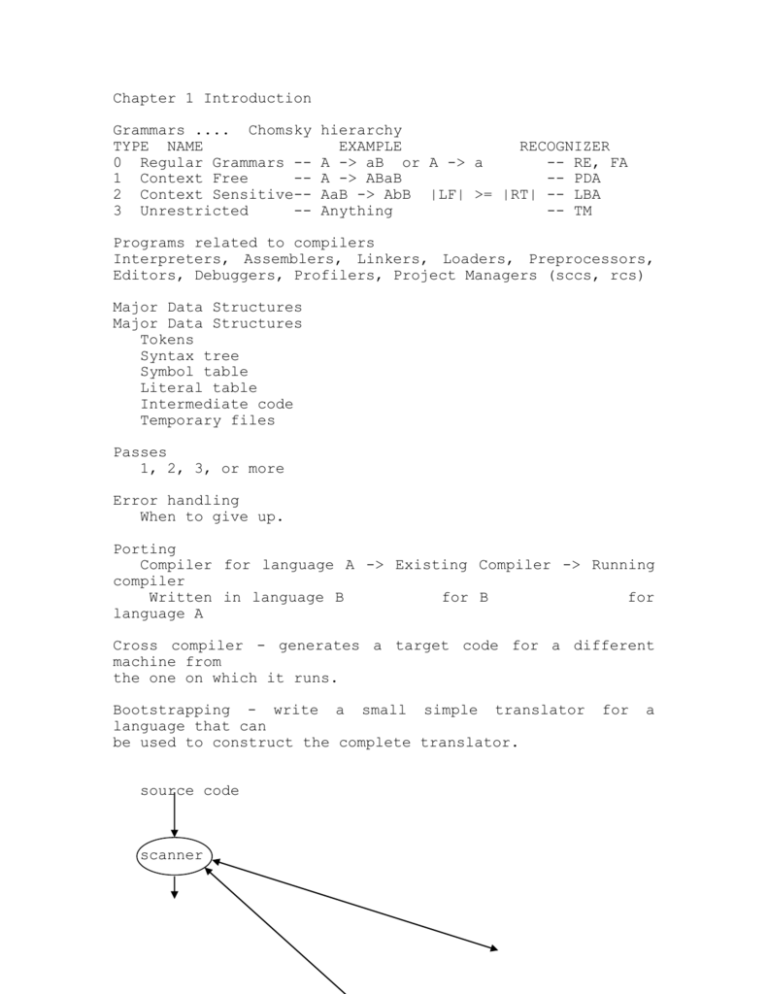
Chapter 1 Introduction
Grammars .... Chomsky
TYPE NAME
0 Regular Grammars -1 Context Free
-2 Context Sensitive-3 Unrestricted
--
hierarchy
EXAMPLE
RECOGNIZER
A -> aB or A -> a
-- RE, FA
A -> ABaB
-- PDA
AaB -> AbB |LF| >= |RT| -- LBA
Anything
-- TM
Programs related to compilers
Interpreters, Assemblers, Linkers, Loaders, Preprocessors,
Editors, Debuggers, Profilers, Project Managers (sccs, rcs)
Major Data Structures
Major Data Structures
Tokens
Syntax tree
Symbol table
Literal table
Intermediate code
Temporary files
Passes
1, 2, 3, or more
Error handling
When to give up.
Porting
Compiler for language A -> Existing Compiler -> Running
compiler
Written in language B
for B
for
language A
Cross compiler - generates a target code for a different
machine from
the one on which it runs.
Bootstrapping - write a small simple translator
language that can
be used to construct the complete translator.
source code
scanner
for
a
tokens
parser
literal table
syntax tree
semantic analyzer
symbol table
annotated tree
source code optimizer
error handler
intermediate code
code generator
target code
target code optimizer
target code
Lexical Analysis
Pattern matching
Applied to other areas such
information retrieval systems.
Programs
strings.
execute
actions
as
triggered
query
by
languages
patterns
Tasks of the lexical analyzer:
strip out comments
remove white space, tab and end of line
correlating error messages associating
with parser error messages
create the listing
preprocessing may be done
line
of
and
in
numbers
Why separate lex and parsing
simpler - a grammar can do both, but this cleaner
faster - lex does lots of i/o, can be separated
portability - different alphabets can be used
tokens, lexemes,
const
const
if
if
relation<,<=
id
pi, d2
inconst 23
patterns
const
if
< or <=
letter followed by letters or digits
digits
typical tokens
keywords, operators, identifiers,
strings and punctuation symbols.
constants,
literal
Some lexical conventions make life tougher
DO 5 I = 1.25 is DO5I = 1.25
FORTRAN
DO 5 I = 1,25 is keyword DO
IF THEN THEN THEN = ELSE; ELSE ELSE = THEN;
PL/1
Attributes for tokens
rel_op matches <, >= etc. but code gen must know which
one
int_const matches 0, 1
Lexical Errors
if 'fi' is encountered, lex returns id, even in wrong
context
bad character in input
cannot form a token
Error recovery
delete characters until the next lexem
inserting a missing character
replace a character
transpose two adjacent characters
Can compute the min number of transformations required to
convert the program into a correct one. Normally not done.
Sometimes done locally.
3 ways of doing lexical analyzer
use LEX
write in a high level language and use language I/O
write in assembler and do your own I/O
Double buffering works quite well
fill one while reading from the other.
ok if token is smaller than the buffer.
Lexical is to scan input and create tokens.
interaction with parser
tokens generated each time required.
tokens written to a file or generated as needed.
Roll of lex with symbol table? Create the symbol table now
or during parsing? Personally, I like during parsing,
however the text discusses the creation during lexical.
specification of tokens
strings and languages
string
length of string
prefix
suffix
substring
empty string
empty set
Operations on Languages
union
concatenation
closure
Lo
=
{}
Regular Expressions
is a re denoting {}, the set containing the empty string
a is re
a | b is re
ab is re
a* is re
(a) - you can have an extra set of parens
digit = [0-9]
nat = digit+
signedNat = (+|-)? nat
number = signedNat (“.” nat)?(E signedNat)?
To implement, one needs a FA.
Some languages cannot be recognized by regular expressions.
id -> letter (letter | digit) *
Draw the FSM for this.
NFA, DFA, Minimize


